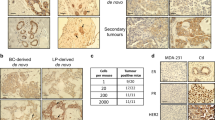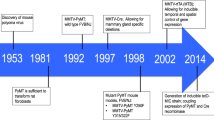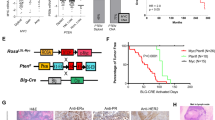Abstract
Several transgenic mouse tumor models were utilized to explore how specific genetic alterations affect the tumor cell response to chemotherapeutic agents in vivo. Specifically, MMTV-ras transgenic mice were interbred to p53 knock-out mice to create a model for assessing the role of p53 in chemotherapeutic responses. In addition, MMTV-ras tumors were compared to MMTV-myc and MMTV-ras/myc tumors. Mice of each genotype reproducibly develop mammary and/or salivary tumors, but tumor growth dynamics vary considerably between genotypes. MMTV-ras/p53−/− tumors exhibit higher S phase fractions than MMTV-ras/p53+/+ tumors, although both tumor types display very low apoptosis levels. In contrast, MMTV-myc tumors exhibit both high S phase fractions and spontaneous apoptosis levels. Tumor-bearing mice of each genotype were treated with either doxorubicin or paclitaxel, and effects on overall tumor growth, cell cycle distribution and apoptosis were evaluated. Surprisingly, neither agent efficiently induced apoptosis in any of the tumor models, including those with wildtype p53. Rather, tumor responses were mediated primarily by changes in cell cycle distribution. However, the spontaneous apoptosis levels did serve as a predictor of tumor growth response, in that only those tumors with high pretreatment apoptosis levels underwent significant regression following treatment with either agent.
This is a preview of subscription content, access via your institution
Access options
Subscribe to this journal
Receive 50 print issues and online access
$259.00 per year
only $5.18 per issue
Buy this article
- Purchase on Springer Link
- Instant access to full article PDF
Prices may be subject to local taxes which are calculated during checkout






Similar content being viewed by others
References
Arends MJ, McGregor AH, Toft NJ, Brown EJH and Wyllie AH. . 1993 Br. J. Cancer 68: 1127–1133.
Barrington RE, Subler MA, Rands E, Omer CA, Miller PJ, Hundley JE, Koester SK, Troyer DA, Bearss DJ, Conner MW, Gibbs JB, Hamilton K, Koblan KS, Mosser SD, O'Neill TJ, Schaber MD, Senderak ET, Windle JJ, Oliff A and Kohl NE. . 1998 Mol. Cell. Biol. 18: 85–92.
Bhalla K, Ibrado AM, Tourkina E, Tang C, Mahoney ME and Huang Y. . 1993 Leukemia 7: 563–568.
Canman CE, Gilmer TM, Coutts SM and Kastan MB. . 1995 Genes Dev. 9: 600–611.
Cardiff RD and Muller WJ. . 1993 Cancer Surv. 16: 97–113.
Cardiff RD and Munn RJ. . 1995 Cancer Lett. 90: 13–19.
Cardiff RD, Sinn E, Muller W and Leder P. . 1991 Am. J. Path. 139: 495–501.
Chabner BA. . 1993 Anticancer drugs. In: Cancer: principles and practice of oncology. DeVita VT, Hellman S and Rosenberg SA (eds). JB Lippincott Co.: Philadelphia pp. 325–417.
Darzynkiewicz Z. . 1994 J. Cell. Biochem. 56: 1–9.
Donehower LA, Godley LA, Aldaz CM, Pyle R, Shi YP, Pinkel D, Gray J, Bradley A, Medina D and Varmus HE. . 1995 Genes Dev. 9: 882–895.
Donehower LA, Harvey M, Slagle BL, McArthur MJ, Montgomery CAJ, Butel JS and Bradley A. . 1992 Nature 356: 215–221.
Dorr RT and Von Hoff DD. . 1994 Cancer Chemotherapy Handbook, 2nd edn. Appleton and Lange: Norwalk, CT.
El-Deiry WS. . 1997 Curr. Opin. Onco. 9: 79–87.
Evan GI, Wyllie AH, Gilbert CS, Littlewood TD, Land H, Brooks M, Waters CM, Penn LZ and Hancock DC. . 1992 Cell 69: 119–128.
Fan S, El-Deiry WS, Bae I, Freeman J, Jondle D, Bhatia K, Fornace Jr AJ, Magrath I, Kohn KW and O'Connor PM. . 1994 Cancer Res. 54: 5824–5830.
Fisher DE. . 1994 Cell 78: 539–542.
Gavrieli Y, Sherman Y and Ben-Sasson SA. . 1992 J. Cell Biol. 119: 493–501.
Hollstein M, Sidransky D, Vogelstein B and Harris CC. . 1991 Science 253: 49–53.
Hundley JE, Koester SK, Troyer DA, Hilsenbeck SG, Barrington RE and Windle JJ. . 1997a Cancer Res. 57: 600–603.
Hundley JE, Koester SK, Troyer DK, Hilsenbeck SG, Subler MA and Windle JJ. . 1997b Mol. Cell. Biol. 17: 723–731.
Jacks T, Remington L, Williams BO, Schmitt EM, Halachmi S, Bronson RT and Weinberg RA. . 1994 Curr. Biol. 4: 1–7.
Kauffmann-Zeh A, Rodriguez-Viciana P, Ulrich E, Gilbert C, Coffer P, Downward J and Evan G. . 1997 Nature 385: 544–548.
Kerr JFR, Winterford CM and Harmon BV. . 1994 Cancer 73: 2013–2026.
Klefstrom J, Arighi E, Littlewood T, Jaattela M, Saksela E, Evan GI and Alitalo K. . 1997 EMBO J. 16: 7382–7392.
Lanni JS, Lowe SW, Licitra EJ, Liu JO and Jacks T. . 1997 Proc. Natl. Acad. Sci. USA 94: 9679–9683.
Lin HJ, Eviner V, Prendergast GC and White E. . 1995 Mol. Cell. Biol. 15: 4536–4544.
Lotem J and Sachs L. . 1993 Cell Growth Differ. 4: 41–47.
Lowe SW, Ruley HE, Jacks T and Housman DE. . 1993 Cell 74: 957–967.
Manfredi JJ and Horwitz SB. . 1984 Pharmacol. Ther. 25: 83–125.
Milas L, Hunter NR, Kurdoglu B, Mason KA, Meyn RE, Stephens LC and Peters LJ. . 1995 Cancer Chemother. Pharmacol. 35: 297–303.
Nelson WG and Kastan MB. . 1994 Mol. Cell. Biol. 14: 1815–1823.
Nooter K, Boersma AW, Oostrum RG, Burger H, Jochemsen AG and Stoter G. . 1995 Br. J. Cancer 71: 556–561.
Polyak K, Waldman T, He T-C, Kinzler KW and Vogelstein B. . 1996 Genes Dev. 10: 1945–1952.
Rowinsky EK and Donehower RC. . 1995 New Engl. J. Med. 332: 1004–1014.
Shao Z-M, Dawson MI, Li XS, Rishi AK, Sheikh MS, Han Q-X, Ordonez JV, Shroot B and Fontana JA. . 1995 Oncogene 11: 493–504.
Sinn E, Muller W, Pattengale P, Tepler I, Wallace R and Leder P. . 1987 Cell 49: 465–475.
Skladanowski A and Konopa J. . 1993 Biochem. Pharmacol. 46: 375–382.
Stewart TA, Pattengale PK and Leder P. . 1984 Cell 38: 627–637.
Tewey KM, Rowe TC, Yand L, Halligan BD and Liu LF. . 1984 Science 226: 466.
Wahl AF, Donaldson KL, Fairchild C, Lee FYF, Foster SA, Demers GW and Galloway DA. . 1996 Nature Med. 2: 72–79.
Waldman T, Zhang Y, Dillehay L, Yu J, Kinzler K and Vogelstein B. . 1997 Nature Med. 3: 1034–1036.
Weinstein JN, Myers TG, O'Connor PM, Friend SH, Fornace Jr AH, Kohn KW, Fojo T, Bates SE, Rubinstein LV, Anderson NL, Buolamwini JK, van Osdol WW, Monks AP, Scudiero DA, Sausville EA, Zaharevitz DW, Bunow B, Viswanadhan VN, Johnson GS, Wittes RE and Paull KD. . 1997 Science 275: 343–349.
Yonish-Rouach E. . 1996 Experienta 52: 1001–1007.
Acknowledgements
This work was supported in part by American Cancer Society grant DHP-150 (to JJ Windle), and by the San Antonio Cancer Institute Cancer Center Support Grant P30 CA54174.
Author information
Authors and Affiliations
Rights and permissions
About this article
Cite this article
Bearss, D., Subler, M., Hundley, J. et al. Genetic determinants of response to chemotherapy in transgenic mouse mammary and salivary tumors. Oncogene 19, 1114–1122 (2000). https://doi.org/10.1038/sj.onc.1203275
Published:
Issue Date:
DOI: https://doi.org/10.1038/sj.onc.1203275
Keywords
This article is cited by
-
Monitoring Immune Cell Function Through Optical Imaging: a Review Highlighting Transgenic Mouse Models
Molecular Imaging and Biology (2022)
-
A nanodroplet cell processing platform facilitating drug synergy evaluations for anti-cancer treatments
Scientific Reports (2019)
-
Establishment of a novel human lymphoblastic cell strain with the long arm of chromosome 11 aberration without MLL rearrangement
Scientific Reports (2017)
-
The mutant p53 mouse as a pre-clinical model
Oncogene (2013)
-
Animal models of breast cancer for the study of pathogenesis and therapeutic insights
Clinical and Translational Oncology (2009)



